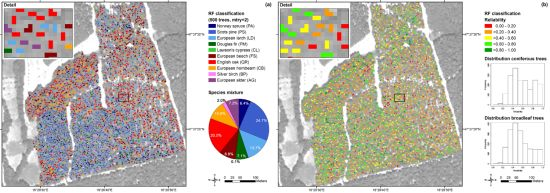Tree Species Classification with Random Forest Using Very High Spatial Resolution 8-Band WorldView-2 Satellite Data
Abstract
:1. Introduction
2. Material
2.1. Study Site
2.2. Reference Data
2.3. Test Area
2.4. WorldView-2 Image
3. Methods
3.1. Spectral Variability Within and Among Tree Species
3.2. Band Correlations
3.3. Random Forest and Linear Discriminant Analysis
3.4. Explanatory Power of the Spectral Bands
3.5. Classification Stability
| UV | Unambiguity for a reference sample (validation); |
| Nmajority | Number of votes for the most frequent class; |
| NOOB | Number of times the sample appears in the out-of-bag (OOB) dataset. |
| UP | Unambiguity for a new sample (prediction); |
| Nmajority | Number of votes for the most frequent class; |
| Ntrees | Number of trees in the RF model. |
| RP | Reliability for a new sample (prediction); |
| UP | Unambiguity for a new sample (prediction); |
| UAcc | User’s accuracy of the most frequent class. |
4. Results
4.1. Object-Based Classification Results for 4 Tree Species
4.2. Object-Based Classification Results for 10 Tree Species
4.3. Pixel-Based Classification Results for 10 Tree Species
4.4. Summary of RF Classification Results and Comparison with LDA
4.5. Classification Stability
4.6. Test Area
4.7. Explanatory Power of the Spectral Bands
5. Discussion
5.1. Spectral Separability of Tree Species
5.2. The Role of the 8 WorldView-2 Bands in Tree Species Classification
5.3. Quality Checks
5.4. Non-Parametric versus Parametric Classification
5.5. Performance of the Pixel-Based and the Object-Based Approach
5.6. Comparison with Other Studies
6. Conclusion
Supplementary
remotesensing-04-02661-s001.docxAcknowledgments
References
- Wulder, M.A.; Hall, R.J.; Coops, N.C.; Franklin, S.E. High spatial resolution remotely sensed data for ecosystem characterization. BioScience 2004, 54, 511–521. [Google Scholar]
- McDermid, G.J.; Hall, R.J.; Sanchez-Azofeifa, G.A.; Franklin, S.E.; Stenhouse, G.B.; Kobliuk, T.; LeDrew, E.F. Remote sensing and forest inventory for wildlife habitat assessment. For. Ecol. Manage 2009, 257, 2262–2269. [Google Scholar]
- Lindenmayer, D.B.; Margules, C.R.; Botkin, D.B. Indicators of biodiversity for ecologically sustainable forest management. Conserv. Biol 2000, 14, 941–950. [Google Scholar]
- Nagendra, H. Using remote sensing to assess biodiversity. Int. J. Remote Sens 2001, 22, 2377–2400. [Google Scholar]
- Clark, M.L.; Roberts, D.A.; Clark, D.B. Hyperspectral discrimination of tropical rain forest tree species at leaf to crown scales. Remote Sens. Environ 2005, 96, 375–398. [Google Scholar]
- Larsen, M. Single tree species classification with a hypothetical multi-spectral satellite. Remote Sens. Environ 2007, 110, 523–532. [Google Scholar]
- Warner, T.A.; Nellis, M.D.; Foody, G.M. Remote Sensing Scale and Data Selection Issues. In The SAGE Handbook of Remote Sensing; SAGE: Thousand Oaks, CA, USA, 2009; Volume 75, pp. 3–17. [Google Scholar]
- Koukal, T.; Atzberger, C. Potential of multi-angular data derived from a digital aerial frame camera for forest classification. IEEE J. Sel. Top. Appl 2012, 5, 30–43. [Google Scholar]
- DigitalGlobe, White Paper: The Benefits of the 8 Spectral Bands of WorldView-2; DigitalGlobe: Longmont, CO, USA, 2009.
- Chen, Q. Comparison of Worldview-2 and IKONOS-2 Imagery for Identifying Tree Species in the Habitat of an Endangered Bird Species in Hawaii; 8-Band Research Challenge; DigitalGlobe: Longmont, CO, USA, 2011. [Google Scholar]
- Sridharan, H. Multi-Level Comparison of WorldView-2 8-Band and AISA Hyperspectral Imageries for Urban Forest Classification; 8-Band Research Challenge; DigitalGlobe: Longmont, CO, USA, 2011. [Google Scholar]
- Omar, H. Commercial Timber Tree Species Identification Using Multispectral Worldview-2 Data; 8-Band Research Challenge; DigitalGlobe: Longmont, CO, USA, 2011. [Google Scholar]
- Latif, Z.A.; Zamri, I.; Omar, H. Determination of Tree Species Using Worldview-2 Data. Proceedings of IEEE 8th International Colloquium on Signal Processing and Its Applications (CSPA), Malacca, Malaysia, 23–25 March 2012; pp. 383–387.
- Cho, M.A.; Naidoo, L.; Mathieu, R.; Asner, G.P. Mapping Savanna Tree Species Using Carnegie Airborne Observatory Hyperspectral Data Resampled to WorldView-2 Multispectral Configuration. Proceedings of 34th International Symposium on Remote Sensing of Environment, Sydney, Australia, 10–15 April 2011.
- Duda, R.O.; Hart, P.E.; Stork, D.G. Pattern Classification, 2nd ed.; John Wiley & Sons: New York, NY, USA, 2000. [Google Scholar]
- Breiman, L. Random forests. Mach. Learn 2001, 45, 5–32. [Google Scholar]
- Hastie, T.; Tibshirani, R.; Friedman, J. The Elements of Statistical Learning: Data Mining, Inference, and Prediction, 2nd ed.; Springer: New York, NY, USA, 2009. [Google Scholar]
- Rodríguez-Galiano, V.F.; Ghimire, B.; Rogan, J.; Chica-Olmo, M.; Rigol-Sanchez, J.P. An assessment of the effectiveness of a random forest classifier for land-cover classification. ISPRS J. Photogramm 2012, 67, 93–104. [Google Scholar]
- Rodríguez-Galiano, V.F.; Abarca-Hernández, F.; Ghimire, B.; Chica-Olmo, M.; Atkinson, P.M.; Jeganathan, C. Incorporating spatial variability measures in land-cover classification using Random Forest. Procedia Envion. Sci 2011, 3, 44–49. [Google Scholar]
- Rodríguez-Galiano, V.F.; Chica-Olmo, M.; Abarca-Hernandez, F.; Atkinson, P.M.; Jeganathan, C. Random Forest classification of Mediterranean land cover using multi-seasonal imagery and multi-seasonal texture. Remote Sens. Environ 2012, 121, 93–107. [Google Scholar]
- Ghimire, B.; Rogan, J.; Miller, J. Contextual land-cover classification: Incorporating spatial dependence in land-cover classification models using Random Forests and the Getis statistic. Remote Sens. Lett 2010, 1, 45–54. [Google Scholar]
- Pal, M. Random forest classifier for remote sensing classification. Int. J. Remote Sens 2005, 26, 217–222. [Google Scholar]
- Miao, X.; Heaton, J.S.; Zheng, S.; Charlet, D.A.; Liu, H. Applying tree-based ensemble algorithms to the classification of ecological zones using multi-temporal multi-source remote-sensing data. Int. J. Remote Sens 2012, 33, 1823–1849. [Google Scholar]
- Clark, M.L.; Roberts, D.A. Species-level differences in hyperspectral metrics among tropical rainforest trees as determined by a tree-based classifier. Remote Sens 2012, 4, 1820–1855. [Google Scholar]
- Naidoo, L.; Cho, M.A.; Mathieu, R.; Asner, G. Classification of savanna tree species, in the Greater Kruger National Park region, by integrating hyperspectral and LiDAR data in a Random Forest data mining environment. ISPRS J. Photogramm. 2012, 69, 167–179. [Google Scholar]
- Lawrence, R.L.; Wood, S.D.; Sheley, R.L. Mapping invasive plants using hyperspectral imagery and Breiman Cutler classifications (randomForest). Remote Sens. Environ 2006, 100, 356–362. [Google Scholar]
- Dalponte, M.; Bruzzone, L.; Gianelle, D. Tree species classification in the Southern Alps based on the fusion of very high geometrical resolution multispectral/hyperspectral images and LiDAR data. Remote Sens. Environ 2012, 123, 258–270. [Google Scholar]
- Stumpf, A.; Kerle, N. Object-oriented mapping of landslides using Random Forests. Remote Sens. Environ 2011, 115, 2564–2577. [Google Scholar]
- Pierce, A.D.; Farris, C.A.; Taylor, A.H. Use of random forests for modeling and mapping forest canopy fuels for fire behavior analysis in Lassen Volcanic National Park, California, USA. For. Ecol. Manage 2012, 279, 77–89. [Google Scholar]
- Hudak, A.T.; Strand, E.K.; Vierling, L.A.; Byrne, J.C.; Eitel, J.U.H.; Martinuzzi, S.; Falkowski, M.J. Quantifying aboveground forest carbon pools and fluxes from repeat LiDAR surveys. Remote Sens. Environ 2012, 123, 25–40. [Google Scholar]
- Guo, L.; Chehata, N.; Mallet, C.; Boukir, S. Relevance of airborne lidar and multispectral image data for urban scene classification using Random Forests. ISPRS J. Photogramm 2011, 66, 56–66. [Google Scholar]
- Hughes, G. On the mean accuracy of statistical pattern recognizers. IEEE T. Inform. Theory 1968, 14, 55–63. [Google Scholar]
- Cortijo, F.J.; Perez De La Blanca, N. The performance of regularized discriminant analysis versus non-parametric classifiers applied to high-dimensional image classification. Int. J. Remote Sens 1999, 20, 3345–3365. [Google Scholar]
- Whiteside, T.G.; Boggs, G.S.; Maier, S.W. Comparing object-based and pixel-based classifications for mapping savannas. Int. J. Appl. Earth Obs. Geoinf 2011, 13, 884–893. [Google Scholar]
- Yan, G.; Mas, J.-F.; Maathuis, B.H.P.; Xiangmin, Z.; Van Dijk, P.M. Comparison of pixel-based and object-oriented image classification approaches—A case study in a coal fire area, Wuda, Inner Mongolia, China. Int. J. Remote Sens 2006, 27, 4039–4055. [Google Scholar]
- Weih, R.C., Jr.; Riggan, N.D., Jr. Object-Based Classification vs. Pixel-Based Classification: Comparitive Importance of Multi-Resolution Imagery. Proceedings of GEOBIA 2010: Geographic Object-Based Image Analysis, Ghent, Belgium, 29 June–2 July 2010; 38, Part 4/C7. p. 6.
- Kilian, W.; Müller, F.; Starlinger, F. Die Forstlichen Wuchsgebiete Österreichs: Eine Naturraumgliederung nach Waldökologischen; FBVA-Berichte; BFW: Vienna, Austria, 1994; p. 60. [Google Scholar]
- Leckie, D.G.; Tinis, S.; Nelson, T.; Burnett, C.; Gougeon, F.A.; Cloney, E.; Paradine, D. Issues in species classification of trees in old growth conifer stands. Can. J. Remote Sens 2005, 31, 175–190. [Google Scholar]
- Greenberg, J.A.; Dobrowski, S.Z.; Ramirez, C.M.; Tull, J.L.; Ustin, S.L. A bottom-up approach to vegetation mapping of the Lake Tahoe Basin using hyperspatial image analysis. Photogramm. Eng. Remote Sensing 2006, 72, 581–589. [Google Scholar]
- Updike, T.; Comp, C. Radiometric Use of WorldView-2 Imagery; DigitalGlobe: Longmont, CO, USA, 2010. [Google Scholar]
- Padwick, C.; Deskevich, M.; Pacifici, F.; Smallwood, S. WorldView-2 Pan-Sharpening. Proceedings of ASPRS 2010 Annual Conference, San Diego, CA, USA, 26–30 April 2010.
- Schlerf, M.; Atzberger, C. Vegetation structure retrieval in beech and spruce forests using spectrodirectional satellite data. IEEE J. Sel. Top. Appl 2012, 5, 8–17. [Google Scholar]
- Hosgood, B.; Jacquemoud, S.; Andreoli, G.; Verdebout, J.; Pedrini, G.; Schmuck, G. Leaf Optical Properties EXperiment 93 (LOPEX93); Report EUR 16095 EN; European Commission Joint Research Centre, Institute for Remote Sensing Applications: Ispra, Italy, 1994; p. 11. [Google Scholar]
- Kadro, A. Untersuchung der Spektralen Reflexionseigenschaften Verschiedener Vegetationsbestände, Ph.D. Dissertation, University Freiburg Freiburg im Breisgau, Germany. 1981.
- Breiman, L. Manual on Setting Up, Using, and Understanding Random Forests V3.1. 2002, p. 29. Available online: http://oz.berkeley.edu/users/breiman/Using_random_forests_V3.1.pdf (accessed on 5 May 2012).
- Liaw, A.; Wiener, M. Classification and regression by randomForest. R news 2002, 2, 18–22. [Google Scholar]
- Haara, A.; Haarala, M. Tree species classification using semi-automatic delineation of trees on aerial images. Scand. J. For. Res 2002, 17, 556–565. [Google Scholar]
- Feret, J.-B.; Asner, G.P.; Jacquemoud, S. Regularization of Discriminant Analysis for the Study of Biodiversity in Humid Tropical Forests. Proceedings of 2011 3rd Workshop on Hyperspectral Image and Signal Processing: Evolution in Remote Sensing (WHISPERS), Lisbon, Portugal, 6–9 June 2011; pp. 1–4.
- Brandtberg, T. Individual tree-based species classification in high spatial resolution aerial images of forests using fuzzy sets. Fuzzy Set. Syst 2002, 132, 371–387. [Google Scholar]
- Olofsson, K.; Wallerman, J.; Holmgren, J.; Olsson, H. Tree species discrimination using Z/I DMC imagery and template matching of single trees. Scand. J. For. Res 2006, 21, 106–110. [Google Scholar]
- Immitzer, M.; Atzberger, C.; Koukal, T. Eignung von WorldView-2 Satellitenbildern für die Baumartenklassifizierung unter besonderer Berücksichtigung der vier neuen Spektralkanäle. Photogramm. Fernerkun 2012, 2012, 573–588. [Google Scholar]
- Puttonen, E.; Litkey, P.; Hyyppä, J. Individual tree species classification by illuminated-shaded area separation. Remote Sens 2009, 2, 19–35. [Google Scholar]
- Efron, B. Estimating the error rate of a prediction rule: Improvement on cross-validation. J. Am. Stat. Assoc 1983, 78, 316–331. [Google Scholar]
- Cohen, J. A coefficient of agreement for nominal scales. Educ. Psychol. Meas 1960, 20, 37–46. [Google Scholar]
- Congalton, R.; Green, K. Assessing the Accuracy of Remotely Sensed Data Principles and Practices; Lewis: Boca Raton, FL, USA, 1999. [Google Scholar]
- Backhaus, K.; Erichson, B.; Plinke, W.; Weiber, R. Multivariate Analysemethoden: Eine anwendungsorientierte Einführung, 12th ed.; Springer: Berlin, Germany, 2008. [Google Scholar]
- R Development Core Team, R: A Language and Environment for Statistical Computing; R Foundation for Statistical Computing: Vienna, Austria, 2012.
- Nakazawa, M. fmsb: Functions for Medical Statistics Book with Some Demographic Data, R Package Version 0.3.4; 2012. Available online: http://CRAN.R-project.org/package=fmsb (accessed on 9 August 2012).
- Venables, W.N.; Ripley, B.D. Modern Applied Statistics with S, 4th ed; Springer: New York, NY, USA, 2002. [Google Scholar]
- Carleer, A.; Wolff, E. Exploitation of very high resolution satellite data for tree species identification. Photogramm. Eng. Remote Sensing 2004, 70, 135–140. [Google Scholar]
- Waser, L.T.; Ginzler, C.; Kuechler, M.; Baltsavias, E.; Hurni, L. Semi-automatic classification of tree species in different forest ecosystems by spectral and geometric variables derived from Airborne Digital Sensor (ADS40) and RC30 data. Remote Sens. Environ 2011, 115, 76–85. [Google Scholar]
- Waser, L.T.; Klonus, S.; Ehlers, M.; Küchler, M.; Jung, A. Potential of digital sensors for land cover and tree species classifications—A case study in the framework of the DGPF-project. Photogramm. Fernerkun 2010, 2010, 141–156. [Google Scholar]
- Voss, M.; Sugumaran, R. Seasonal effect on tree species classification in an urban environment using hyperspectral data, LiDAR, and an object-oriented approach. Sensors 2008, 8, 3020–3036. [Google Scholar]
- Jones, T.G.; Coops, N.C.; Sharma, T. Assessing the utility of airborne hyperspectral and LiDAR data for species distribution mapping in the coastal Pacific Northwest, Canada. Remote Sens. Environ 2010, 114, 2841–2852. [Google Scholar]
- Mendez, G.; Buskirk, T.D.; Lohr, S.; Haag, S. Factors associated with persistence in science and engineering majors: An exploratory study using classification trees and random forests. J. Eng. Educ 2008, 97, 57–69. [Google Scholar]
- Nicodemus, K.K.; Malley, J.D. Predictor correlation impacts machine learning algorithms: Implications for genomic studies. Bioinformatics 2009, 25, 1884–1890. [Google Scholar]
- Nicodemus, K.K. Letter to the editor: on the stability and ranking of predictors from random forest variable importance measures. Brief Bioinform 2011, 12, 369–373. [Google Scholar]
- Atzberger, C.; Richter, K. Spatially constrained inversion of radiative transfer models for improved LAI mapping from future Sentinel-2 imagery. Remote Sens. Environ 2012, 120, 208–218. [Google Scholar]
- Holmgren, J.; Persson, Å.; Söderman, U. Species identification of individual trees by combining high resolution LiDAR data with multi-spectral images. Int. J. Remote Sens 2008, 29, 1537–1552. [Google Scholar]
- Dalponte, M.; Bruzzone, L.; Gianelle, D. Fusion of hyperspectral and LIDAR remote sensing data for classification of complex forest areas. IEEE Trans Geosci. Remote Sens 2008, 46, 1416–1427. [Google Scholar]
- Straub, C.; Weinacker, H.; Koch, B. A comparison of different methods for forest resource estimation using information from airborne laser scanning and CIR orthophotos. Eur. J. For. Res 2010, 129, 1069–1080. [Google Scholar]
- Erins, G.; Lorencs, A.; Mednieks, I.; Sinica-Sinavskis, J. Tree Species Classification in Mixed Baltic Forest. Proceedings of 2011 3rd Workshop on Hyperspectral Image and Signal Processing: Evolution in Remote Sensing (WHISPERS), Lisbon, Portugal, 6–9 June 2011; pp. 1–4.
- Heinzel, J.N.; Weinacker, H.; Koch, B. Full Automatic Detection of Tree Species Based on Delineated Single Tree Crowns—A Data Fusion Approach for Airborne Laser Scanning Data and Aerial Photographs. Proceedings of SilviLaser 8th International Conference on LiDAR Applications in Forest Assessment and Inventory, Edinburgh, UK, 17–19 September 2008; pp. 76–85.
- Brandtberg, T. Automatic individual tree based analysis of high spatial resolution aerial images on naturally regenerated boreal forests. Can. J. For. Res 1999, 29, 1464–1478. [Google Scholar]
- Kanda, F.; Kubo, M.; Muramoto, K. Watershed Segmentation and Classification of Tree Species Using High Resolution Forest Imagery. Proceedings of 2004 IEEE International Geoscience and Remote Sensing Symposium, Anchorage, AK, USA, 20–24 September 2004; Volume 6. pp. 3822–3825.
- Wang, L.; Gong, P.; Biging, G.S. Individual tree-crown delineation and treetop detection in high-spatial-resolution aerial imagery. Photogramm. Eng. Remote Sensing 2004, 70, 351–357. [Google Scholar]
- Niccolai, A.; Hohl, A.; Niccolai, M.; Oliver, C.D. Integration of varying spatial, spectral and temporal high-resolution optical images for individual tree crown isolation. Int. J. Remote Sens 2010, 31, 5061–5088. [Google Scholar]
- Culvenor, D.S. TIDA: An algorithm for the delineation of tree crowns in high spatial resolution remotely sensed imagery. Comput. Geosci 2002, 28, 33–44. [Google Scholar]
- Erikson, M. Segmentation of individual tree crowns in colour aerial photographs using region growing supported by fuzzy rules. Can. J. For. Res 2003, 33, 1557–1563. [Google Scholar]
- Leckie, D.G.; Gougeon, F.A.; Tinis, S.; Nelson, T.; Burnett, C.N.; Paradine, D. Automated tree recognition in old growth conifer stands with high resolution digital imagery. Remote Sens. Environ 2005, 94, 311–326. [Google Scholar]
- Katoh, M.; Gougeon, F.A. Improving the precision of tree counting by combining tree detection with crown delineation and classification on homogeneity guided smoothed high resolution (50 cm) multispectral airborne digital data. Remote Sens 2012, 4, 1411–1424. [Google Scholar]
- Culvenor, D.S. Extracting Individual Tree Information: A Survey of Techniques for High Spatial Resolution Imagery. In Remote Sensing of Forest Environments: Concepts and Case Studies; Wulder, M.A., Franklin, S.E., Eds.; Kluwer Academic Publishers: Norwell, MA, USA, 2003; pp. 255–277. [Google Scholar]
- Wolf, B.-M.; Heipke, C. Automatic extraction and delineation of single trees from remote sensing data. Mach. Vision Appl 2007, 18, 317–330. [Google Scholar]
- Korpela, I. Individual Tree Measurements by Means of Digital Aerial Photogrammetry; Silva Fennica Monographs 3; Finnish Society of Forest Science: Helsinki, Finland, 2004. [Google Scholar]
- Heikkinen, V.; Korpela, I.; Tokola, T.; Honkavaara, E.; Parkkinen, J. An SVM classification of tree species radiometric signatures based on the Leica ADS40 sensor. IEEE Trans. Geosci. Remote Sens 2011, 49, 4539–4551. [Google Scholar]
- Erikson, M. Species classification of individually segmented tree crowns in high-resolution aerial images using radiometric and morphologic image measures. Remote Sens. Environ 2004, 91, 469–477. [Google Scholar]
- Stoffels, J.; Mader, S.; Hill, J.; Werner, W.; Ontrup, G. Satellite-based stand-wise forest cover type mapping using a spatially adaptive classification approach. Eur. J. For. Res 2012, 4, 1071–1089. [Google Scholar]
- Leckie, D.G.; Gougeon, F.A.; Walsworth, N.; Paradine, D. Stand delineation and composition estimation using semi-automated individual tree crown analysis. Remote Sens. Environ 2003, 85, 355–369. [Google Scholar]
- Hill, R.A.; Wilson, A.K.; George, M.; Hinsley, S.A. Mapping tree species in temperate deciduous woodland using time-series multi-spectral data. Appl. Veg. Sci 2010, 13, 86–99. [Google Scholar]
- Kim, S.-R.; Lee, W.-K.; Kwak, D.-A.; Biging, G.S.; Gong, P.; Lee, J.-H.; Cho, H.-K. Forest cover classification by optimal segmentation of high resolution satellite imagery. Sensors 2011, 11, 1943–1958. [Google Scholar]
- Boschetti, M.; Boschetti, L.; Oliveri, S.; Casati, L.; Canova, I. Tree species mapping with airborne hyper-spectral MIVIS data: The Ticino Park study case. Int. J. Remote Sens 2007, 28, 1251–1261. [Google Scholar]
- Dalponte, M.; Bruzzone, L.; Gianelle, D. Tree Species Classification in the Southern Alps with Very High Geometrical Resolution Multispectral and Hyperspectral Data. Proceedings of 2011 3rd Workshop on Hyperspectral Image and Signal Processing: Evolution in Remote Sensing (WHISPERS), Lisbon, Portugal, 6–9 June 2011; pp. 1–4.
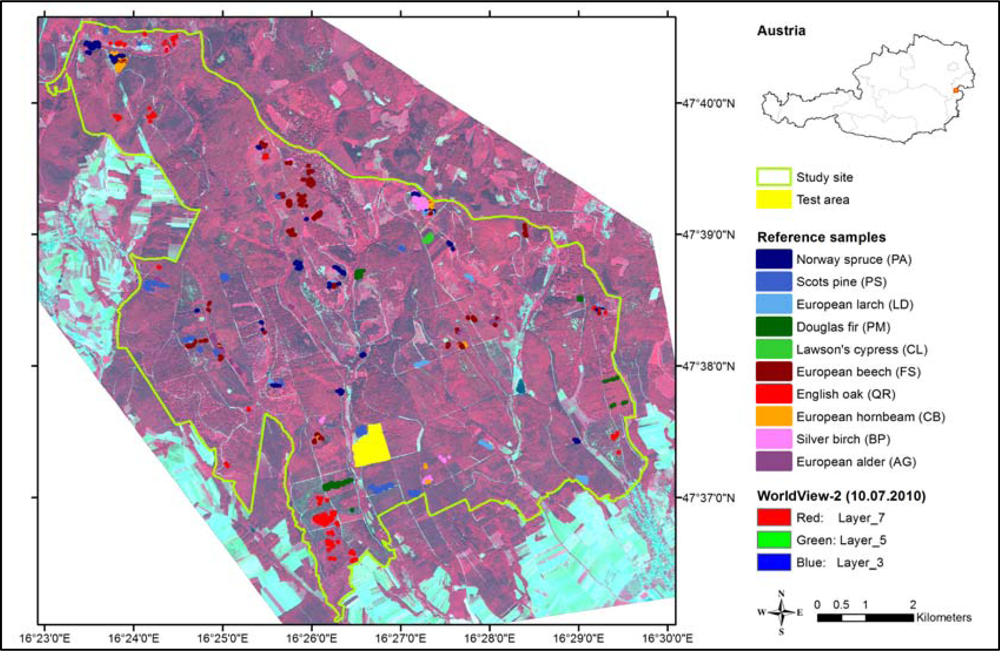
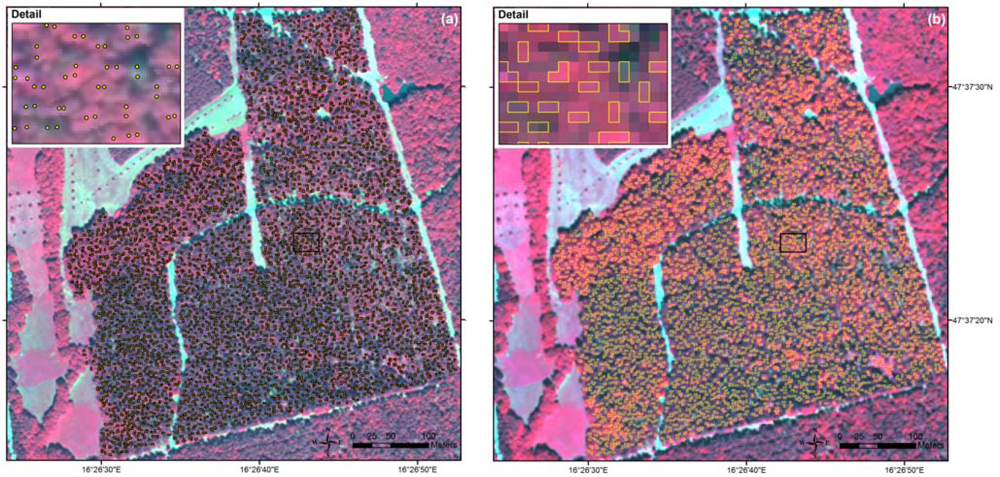
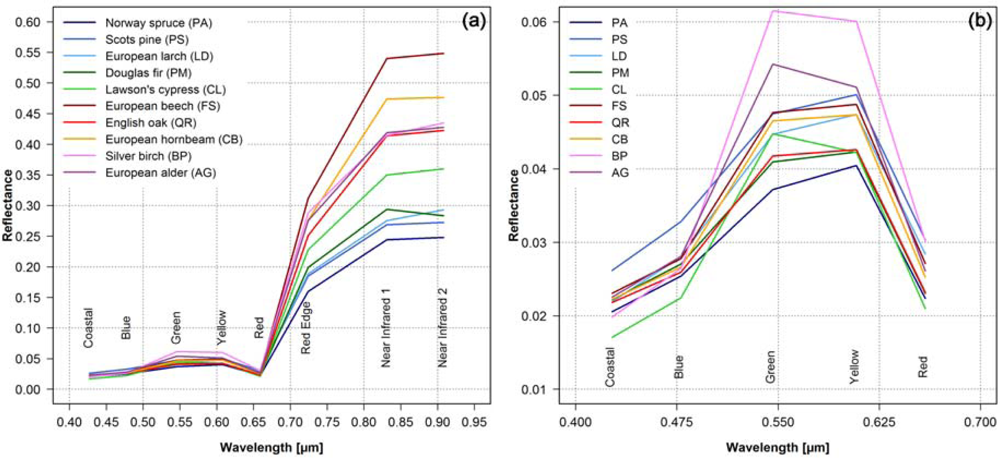
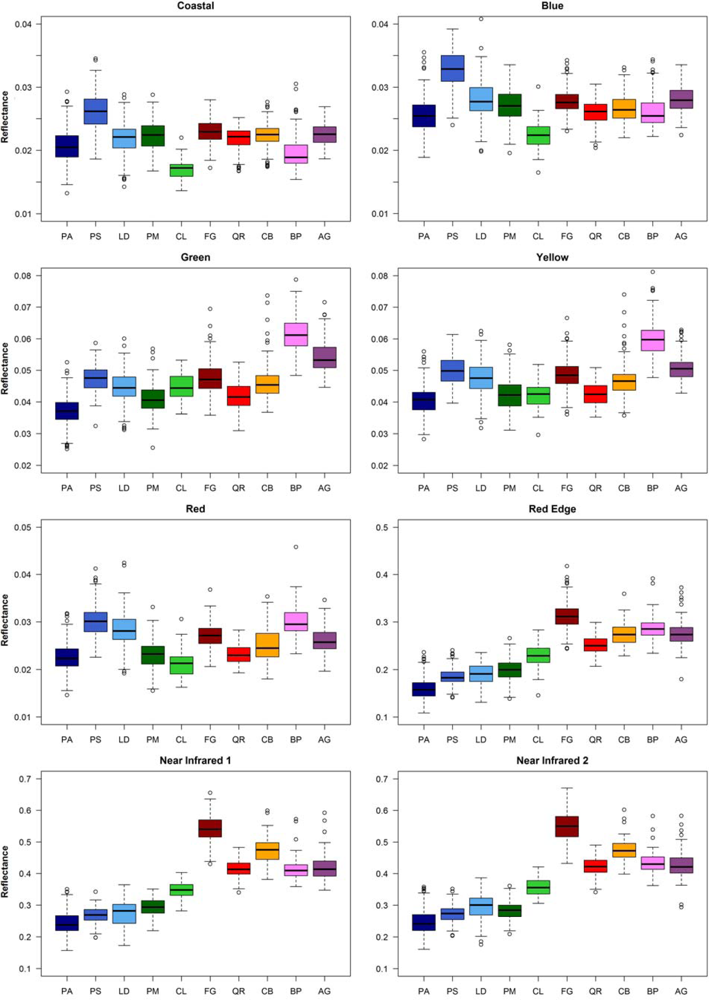

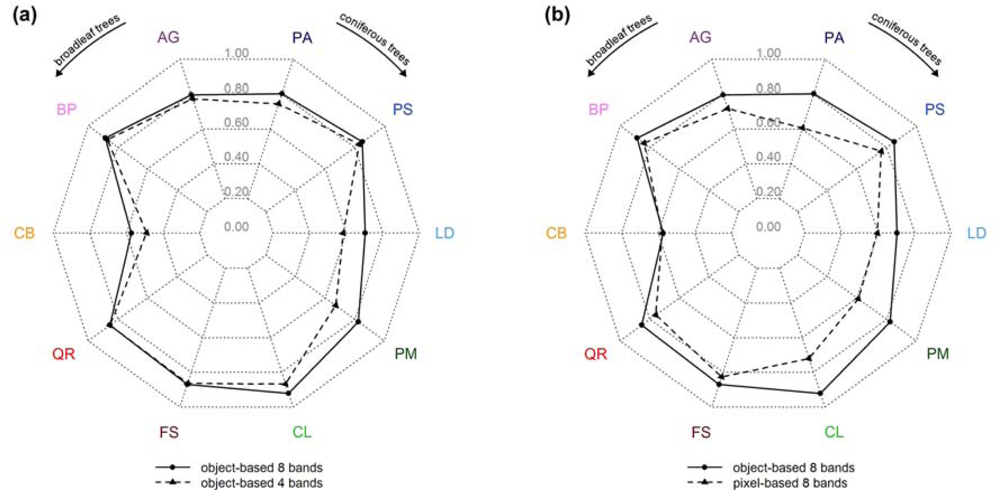
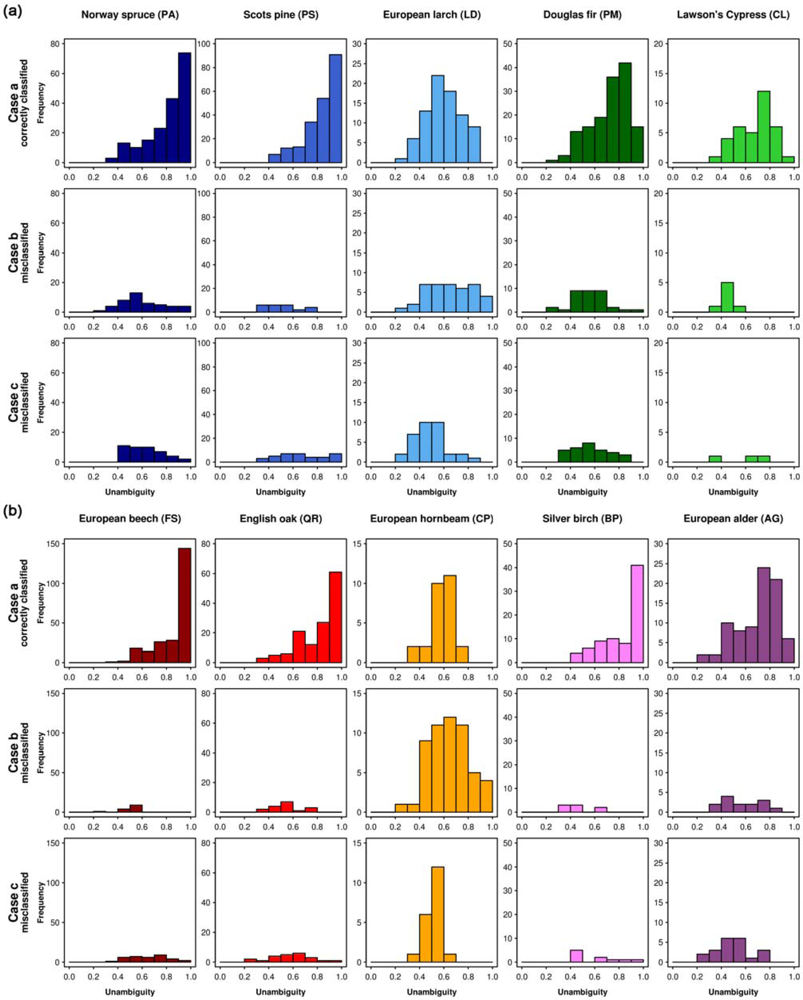

| Common Name | Scientific Name | Acronym | Type | Leaf Phenology | No. of Pixels | No. of Objects | Proportion1 [%] |
|---|---|---|---|---|---|---|---|
| Norway spruce | Picea abies | PA | Conifer | Evergreen | 1,084 | 226 | 15.4 |
| Scots pine | Pinus sylvestris | PS | Conifer | Evergreen | 807 | 235 | 16.0 |
| European larch | Larix decidua | LD | Conifer | Deciduous | 472 | 122 | 8.3 |
| Douglas fir | Pseudotsuga menziesii | PM | Conifer | Evergreen | 677 | 178 | 12.1 |
| Lawson’s cypress | Chamaecyparis lawsoniana | CL | Conifer | Evergreen | 166 | 42 | 2.9 |
| European beech | Fagus sylvatica | FS | Broadleaf | Deciduous | 1,519 | 247 | 16.9 |
| English oak | Quercus robur | QR | Broadleaf | Deciduous | 1,770 | 152 | 10.4 |
| European hornbeam | Carpinus betulus | CB | Broadleaf | Deciduous | 445 | 81 | 5.5 |
| Silver birch | Betula pendula | BP | Broadleaf | Deciduous | 397 | 86 | 5.9 |
| European alder | Alnus glutinosa | AG | Broadleaf | Deciduous | 387 | 96 | 6.6 |
| 7,724 | 1,465 | 100.0 | |||||
| Group | Band | Coastal | Blue | Green | Yellow | Red | Red Edge | Near Infrared 1 | Near Infrared 2 |
|---|---|---|---|---|---|---|---|---|---|
| A | Coastal | - | 0.88 | 0.36 | 0.48 | 0.64 | 0.11 | 0.08 | 0.06 |
| Blue | 0.88 | - | 0.48 | 0.57 | 0.77 | 0.05 | −0.02 | −0.04 | |
| B | Green | 0.36 | 0.48 | - | 0.90 | 0.72 | 0.61 | 0.44 | 0.45 |
| Yellow | 0.48 | 0.57 | 0.90 | - | 0.82 | 0.51 | 0.33 | 0.35 | |
| Red | 0.64 | 0.77 | 0.72 | 0.82 | - | 0.26 | 0.14 | 0.16 | |
| C | Red Edge | 0.11 | 0.05 | 0.61 | 0.51 | 0.26 | - | 0.95 | 0.95 |
| Near Infrared 1 | 0.08 | −0.02 | 0.44 | 0.33 | 0.14 | 0.95 | - | 0.98 | |
| Near Infrared 2 | 0.06 | −0.04 | 0.45 | 0.35 | 0.16 | 0.95 | 0.98 | - | |
| Case | Majority vote | Reference | Classified as |
|---|---|---|---|
| a | correct | tree species i | tree species i |
| b | wrong | tree species i | not tree species i |
| c | wrong | not tree species i | tree species i |
| Reference Data | ||||||
|---|---|---|---|---|---|---|
| Classified as | PA | PS | FS | QR | Σ | User’s acc. |
| PA | 211 | 12 | 0 | 0 | 223 | 0.946 |
| PS | 15 | 223 | 0 | 0 | 238 | 0.937 |
| FS | 0 | 0 | 243 | 4 | 247 | 0.980 |
| QR | 0 | 0 | 4 | 148 | 152 | 0.974 |
| Σ | 226 | 235 | 247 | 152 | 860 | |
| Prod. acc. | 0.934 | 0.949 | 0.984 | 0.974 | 0.959 | |
| Reference Data | ||||||||||||
|---|---|---|---|---|---|---|---|---|---|---|---|---|
| Classified as | PA | PS | LD | PM | CL | FS | QR | CB | BP | AG | Σ | User’s acc. |
| PA | 181 | 8 | 18 | 17 | 1 | 0 | 0 | 0 | 0 | 0 | 225 | 0.804 |
| PS | 11 | 211 | 18 | 8 | 0 | 0 | 0 | 0 | 0 | 0 | 248 | 0.851 |
| LD | 10 | 14 | 81 | 8 | 1 | 0 | 0 | 0 | 0 | 1 | 115 | 0.704 |
| PM | 24 | 2 | 4 | 144 | 0 | 0 | 0 | 0 | 0 | 1 | 175 | 0.823 |
| CL | 0 | 0 | 0 | 0 | 35 | 0 | 0 | 0 | 1 | 2 | 38 | 0.921 |
| FS | 0 | 0 | 0 | 0 | 0 | 233 | 1 | 28 | 3 | 3 | 268 | 0.869 |
| QR | 0 | 0 | 1 | 0 | 0 | 2 | 135 | 15 | 0 | 5 | 158 | 0.854 |
| CB | 0 | 0 | 0 | 0 | 0 | 11 | 9 | 27 | 0 | 0 | 47 | 0.574 |
| BP | 0 | 0 | 0 | 0 | 1 | 1 | 0 | 6 | 78 | 2 | 88 | 0.886 |
| AG | 0 | 0 | 0 | 1 | 4 | 0 | 7 | 5 | 4 | 82 | 103 | 0.796 |
| Σ | 226 | 235 | 122 | 178 | 42 | 247 | 152 | 81 | 86 | 96 | 1465 | |
| Prod. acc. | 0.801 | 0.898 | 0.664 | 0.809 | 0.833 | 0.943 | 0.888 | 0.333 | 0.907 | 0.854 | 0.824 | |
| Reference Data | ||||||||||||
|---|---|---|---|---|---|---|---|---|---|---|---|---|
| Classified as | PA | PS | LD | PM | CL | FS | QR | CB | BP | AG | Σ | User’s acc. |
| PA | 167 | 7 | 20 | 29 | 1 | 0 | 0 | 0 | 0 | 0 | 224 | 0.746 |
| PS | 10 | 204 | 24 | 8 | 0 | 0 | 0 | 0 | 0 | 0 | 246 | 0.829 |
| LD | 11 | 17 | 63 | 14 | 1 | 0 | 0 | 1 | 0 | 1 | 108 | 0.583 |
| PM | 38 | 7 | 12 | 124 | 3 | 0 | 1 | 0 | 0 | 0 | 185 | 0.670 |
| CL | 0 | 0 | 0 | 2 | 33 | 0 | 0 | 0 | 0 | 3 | 38 | 0.868 |
| FS | 0 | 0 | 0 | 0 | 0 | 227 | 1 | 31 | 1 | 3 | 263 | 0.863 |
| QR | 0 | 0 | 1 | 1 | 0 | 2 | 140 | 15 | 0 | 5 | 164 | 0.854 |
| CB | 0 | 0 | 1 | 0 | 0 | 17 | 6 | 24 | 1 | 0 | 49 | 0.490 |
| BP | 0 | 0 | 0 | 0 | 0 | 1 | 0 | 5 | 75 | 5 | 86 | 0.872 |
| AG | 0 | 0 | 1 | 0 | 4 | 0 | 4 | 5 | 9 | 79 | 102 | 0.775 |
| Σ | 226 | 235 | 122 | 178 | 42 | 247 | 152 | 81 | 86 | 96 | 1465 | |
| Prod. acc. | 0.739 | 0.868 | 0.516 | 0.697 | 0.786 | 0.919 | 0.921 | 0.296 | 0.872 | 0.823 | 0.775 | |
| Reference Data | ||||||||||||
|---|---|---|---|---|---|---|---|---|---|---|---|---|
| Classified as | PA | PS | LD | PM | CL | FS | QR | CB | BP | AG | Σ | User’s acc. |
| PA | 755 | 125 | 143 | 186 | 4 | 3 | 12 | 1 | 6 | 9 | 1244 | 0.607 |
| PS | 109 | 629 | 51 | 30 | 0 | 0 | 4 | 1 | 0 | 0 | 824 | 0.763 |
| LD | 41 | 28 | 202 | 35 | 5 | 1 | 11 | 5 | 9 | 2 | 339 | 0.596 |
| PM | 141 | 21 | 48 | 393 | 12 | 0 | 21 | 0 | 5 | 5 | 646 | 0.608 |
| CL | 4 | 0 | 1 | 6 | 103 | 1 | 2 | 1 | 17 | 8 | 143 | 0.720 |
| FS | 0 | 0 | 1 | 0 | 0 | 1330 | 89 | 165 | 6 | 19 | 1610 | 0.826 |
| QR | 27 | 3 | 15 | 22 | 15 | 154 | 1589 | 167 | 16 | 86 | 2094 | 0.759 |
| CB | 0 | 0 | 0 | 0 | 0 | 26 | 15 | 70 | 6 | 4 | 121 | 0.579 |
| BP | 0 | 1 | 3 | 2 | 15 | 0 | 1 | 23 | 310 | 15 | 370 | 0.838 |
| AG | 7 | 0 | 8 | 3 | 12 | 4 | 26 | 12 | 22 | 239 | 333 | 0.718 |
| Σ | 1084 | 807 | 472 | 677 | 166 | 1519 | 1770 | 445 | 397 | 387 | 7724 | |
| Prod. acc. | 0.696 | 0.779 | 0.428 | 0.581 | 0.620 | 0.876 | 0.898 | 0.157 | 0.781 | 0.618 | 0.728 | |
| Tree Species | Approach | WorldView-2 Bands1 | RF | LDA | ||
|---|---|---|---|---|---|---|
| Overall acc. | Kappa | Overall acc. | Kappa | |||
| 4 | pixel-based | 4 (B,G,R,NIR1) | 0.868 | 0.819 | 0.849 | 0.793 |
| 8 (C,B,G,Y,R,RE,NIR1,NIR2) | 0.881 | 0.837 | 0.862 | 0.810 | ||
| object-based | 4 (B,G,R,NIR1) | 0.955 | 0.939 | 0.949 | 0.931 | |
| 8 (C,B,G,Y,R,RE,NIR1,NIR2) | 0.959 | 0.945 | 0.944 | 0.925 | ||
| 10 | pixel-based | 4 (B,G,R,NIR1) | 0.690 | 0.634 | 0.657 | 0.593 |
| 8 (C,B,G,Y,R,RE,NIR1,NIR2) | 0.728 | 0.678 | 0.700 | 0.645 | ||
| object-based | 4 (B,G,R,NIR1) | 0.775 | 0.743 | 0.786 | 0.756 | |
| 8 (C,B,G,Y,R,RE,NIR1,NIR2) | 0.824 | 0.799 | 0.835 | 0.811 | ||
| Band | Group | MDA | MDG | MDFC | Wilks’ Lambda |
|---|---|---|---|---|---|
| Coastal | A | 0.896 (5) | 117.8 (8) | 0.295 (5) | 0.580 (8) |
| Blue | 0.899 (3) | 130.9 (6) | 0.407 (3) | 0.507 (7) | |
| Green | B | 0.909 (1) | 145.2 (4) | 0.470 (2) | 0.392 (4) |
| Yellow | 0.876 (7) | 118.0 (7) | 0.257 (6) | 0.471 (5) | |
| Red | 0.898 (4) | 132.0 (5) | 0.256 (7) | 0.495 (6) | |
| Red Edge | C | 0.858 (8) | 184.0 (3) | 0.183 (8) | 0.154 (3) |
| Near Infrared 1 | 0.903 (2) | 238.3 (1) | 0.650 (1) | 0.096 (1) | |
| Near Infrared 2 | 0.887 (6) | 219.1 (2) | 0.361 (4) | 0.099 (2) | |
| Basis of the 4-Band Combination | 4-Band Combination1 | Overall acc. RF | Overall acc. LDA |
|---|---|---|---|
| best classification result RF | C, G, R, NIR1 | 0.792 | 0.782 |
| best classification result LDA | B, G, R, NIR1 | 0.777 | 0.790 |
| MDA | B, G, R, NIR1 | 0.777 | 0.790 |
| MDG | G, RE, NIR1, NIR2 | 0.726 | 0.746 |
| MDFC | B, G, NIR1, NIR2 | 0.753 | 0.767 |
| Wilks’ Lambda | G, RE, NIR1, NIR2 | 0.726 | 0.746 |
| Platform1 | Datatyp2 | Sensor | Acquisition date | LiDAR3 | Classification algorithm4 | Approach5 | Species no. | Overall acc. [%]6 | Kappa6 | Tree species | Reference |
|---|---|---|---|---|---|---|---|---|---|---|---|
| A | M | DMC | Jun | x | ML | OI | 3 | 96 | 0.93 | Picea abies, Pinus sylvestris & broadleaf trees | [69] |
| A | M | DMC | Oct | ML | OI | 3 | 91 | 0.87 | Picea abies, Pinus sylvestris & broadleaf trees | [69] | |
| A | M | Wild RC 20 | May & Jul | MD | OI | 3 | 91 | 0.86 | Picea abies, Pinus sylvestris & Betula pendula | [84] | |
| A | M | DMC | Oct | LDA | OI | 3 | 89 | 0.82 | Picea abies, Pinus sylvestris & broadleaf trees | [50] | |
| A | M | ADS40-SH52 | Aug | SVM | OI | 3 | 88 | n.s. | Pinus sylvestris, Picea abies & Betula sp. | [85] | |
| H | M | DCRTRV20 | Oct | ML | OS | 3 | 87 | n.s. | Larix sp., Cryptomeria japonica, Fagus sp. | [75] | |
| A | M | DMC | Jun | ML | OI | 3 | 84 | 0.76 | Picea abies, Pinus sylvestris & broadleaf trees | [69] | |
| A | M | n.s. | n.s. | x | DT | OI | 3 | 84 | n.s. | Fagus sylvatica, Quercus sp. / Carpinus betulus & conifers | [73] |
| A | M | Wild RC 20 | Jun | LDA | OI | 3 | 78 | n.s. | Picea abies, Pinus sylvestris & broadleaf trees | [47] | |
| A | M | DMC | Sep | LDA | OI | 3 | 68 | n.s. | Picea abies, Pinus sylvestris & Betula sp. | [52] | |
| A | M | ADS40-SH52 | Sep | ANN | OI | 4 | 84 | 0.73 | Picea abies, Pinus sylvestris, Larix decidua & Betula sp. | [61] | |
| A | M | Wild RC30/4 | Aug | DT | OI | 4 | 77 | n.s. | Picea abies, Pinus sylvestris, Betula pubescens & Populus tremula | [86] | |
| A | M | n.s. | Aug | LDA | OI | 4 | 67 | n.s. | Picea abies, Pinus sylvestris, Betula pubescens & Populus tremula | [49] | |
| S | M | ASTER | Apr & Jun | ACA | OS | 5 | 87 | 0.83 | Picea abies, Pinus sylvestris, Pseudotsuga menziesii, Fagus sylvatica, & Quercus sp. | [87] | |
| S | M | ASTER | Apr & Jun | ML | OS | 5 | 82 | 0.77 | Picea abies, Pinus sylvestris, Pseudotsuga menziesii, Fagus sylvatica, & Quercus sp. | [87] | |
| A | M | CASI | Sep | ML | OI | 6 | 93 | n.s. | Pseudotsuga menziesii, Abies grandis, Abies amabilis, Thuja plicata, Tsuga heterophylla & hardwood | [88] | |
| A | M | ATM | Oct | ML | OI | 6 | 84 | 0.79 | Fraxinus excelsior, Quercus robur, Acer campestre, Betula pendula, Populus tremula & Ulmus minor | [89] | |
| A | M | ATM | Mar, Jul & Oct | ML | OI | 6 | 71 | 0.63 | Fraxinus excelsior, Quercus robur, Acer campestre, Betula pendula, Populus tremula & Ulmus minor | [89] | |
| A | H | AISA | Jul | x | NN | OI | 6 | 57 | n.s. | Pinus strobus, Picea glauca, Gleditsia triacanthos, Acer saccharum, Tilia Americana & Quercus palustris | [63] |
| A | H | AISA | Jul | NN | OI | 6 | 48 | n.s. | Pinus strobus, Picea glauca, Gleditsia triacanthos, Acer saccharum, Tilia Americana & Quercus palustris | [63] | |
| A | H | AISA | Oct | NN | OI | 6 | 45 | n.s. | Pinus strobus, Picea glauca, Gleditsia triacanthos, Acer saccharum, Tilia Americana & Quercus palustris | [63] | |
| S | M | IKONOS | Jun | ML | P | 7 | 86 | 0.84 | Pinus sylvestris, Pinus nigra subsp. Laricio, Larix decidua, Pseudotsuga menziesii, Fagus sylvatica, Fagus sylvatica purpure & Quercus sp. | [60] | |
| A | H | AISA | Jul | x | SVM | OI | 7 | 83 | 0.77 | Picea abies, Abies alba, Pinus mugo, Pinus sylvestris, Larix decidua, Fagus sylvatica, & other broadleaf (& non forest) | [27] |
| S | M | IKONOS | May | ML | PA | 7 | 77 | 0.73 | Pinus rigida, Pinus koraiensis, Larix leptolepis, Quercus mongolica, Quercus variabilis, Quercus acutissima & Castanea crenata | [90] | |
| A | M | ADS40-SH40& RC30 | Sep | ANN | OI | 7 | 76 | 0.70 | Picea abies, Pinus sylvestris, Abies alba, Larix decidua, Fagus sylvatica, Fraxinus excelsior, Acer sp., Alnus sp., & Betula sp. | [61] | |
| A | H | MIVIS | Jul | ML | OI | 7 | 75 | 0.67 | Pinus sp., Castanea sativa, Alnus sp., Salix sp., Populus sp., Quercus sp. & Alien species | [91] | |
| A | H | AISA | Jul | SVM | OI | 7 | 74 | 0.66 | Picea abies, Abies alba, Pinus mugo, Pinus sylvestris, Larix decidua, Fagus sylvatica, & other broadleaf (& non forest) | [27] | |
| A | M | DMC | Aug | LR | OI | 8 | 88 | 0.86 | Picea abies, Pinus sylvestris, Acer sp., Fagus sp., Fraxinus sp., Populus sp., Salix sp. & Quercus sp. | [62] | |
| A | H | AISA | Jul | SVM | P | 11 | n.s. | 0.75 | Picea abies, Pinus sylvestris, Pinus mugo, Abies alba, Larix decidua, Fagus sylvatica, Fraxinus excelsior, Acer pseudoplatanus, Ostrya carpinifolia, Quercus petraea, Ulmus glabra (& non forest) | [92] | |
| A | H | AISA | Jul | x | SVM | OI | 11 | 74 | 0.60 | Abies grandis, Thuja plicata, Pseudotsuga menziesii, Tsuga heterophylla, Pinus contorta, Populus balsamifera, Populus tremuloides, Alnus rubra, Acer macrophylum, Quercus garryana & Arbutus menziesii, | [64] |
| A | H | AISA | Jul | SVM | OI | 11 | 72 | 0.60 | Abies grandis, Thuja plicata, Pseudotsuga menziesii, Tsuga heterophylla, Pinus contorta, Populus balsamifera, Populus tremuloides, Alnus rubra, Acer macrophylum, Quercus garryana & Arbutus menziesii, | [64] | |
| S | M | GeoEye-1 | Sep | SVM | P | 11 | n.s. | 0.51 | Picea abies, Pinus sylvestris, Pinus mugo, Abies alba, Larix decidua, Fagus sylvatica, Fraxinus excelsior, Acer pseudoplatanus, Ostrya carpinifolia, Quercus petraea, Ulmus glabra (& non forest) | [92] | |
| S | M | IKONOS | Jul | ML | P | 16 | 58 | 0.50 | Abies concolor, Abies magnifica, Juniperus occidentalis, Pinus albicaulis, Pinus contorta, Pinus jeffreyi, Pinus monticola, Tsuga mertensiana, Populus tremuloides, Alnus incana, Arctostaphylos patula, Artemesia tridentate, Ceanothus cordulatus, Ceanothus velutinus, Quercus vaccinifolia, Salix sp. (& 3 grass species; results without class ‘water’) | [39] | |
Share and Cite
Immitzer, M.; Atzberger, C.; Koukal, T. Tree Species Classification with Random Forest Using Very High Spatial Resolution 8-Band WorldView-2 Satellite Data. Remote Sens. 2012, 4, 2661-2693. https://doi.org/10.3390/rs4092661
Immitzer M, Atzberger C, Koukal T. Tree Species Classification with Random Forest Using Very High Spatial Resolution 8-Band WorldView-2 Satellite Data. Remote Sensing. 2012; 4(9):2661-2693. https://doi.org/10.3390/rs4092661
Chicago/Turabian StyleImmitzer, Markus, Clement Atzberger, and Tatjana Koukal. 2012. "Tree Species Classification with Random Forest Using Very High Spatial Resolution 8-Band WorldView-2 Satellite Data" Remote Sensing 4, no. 9: 2661-2693. https://doi.org/10.3390/rs4092661





